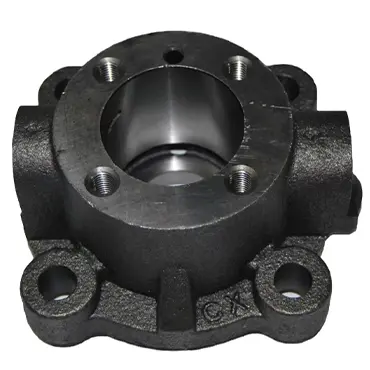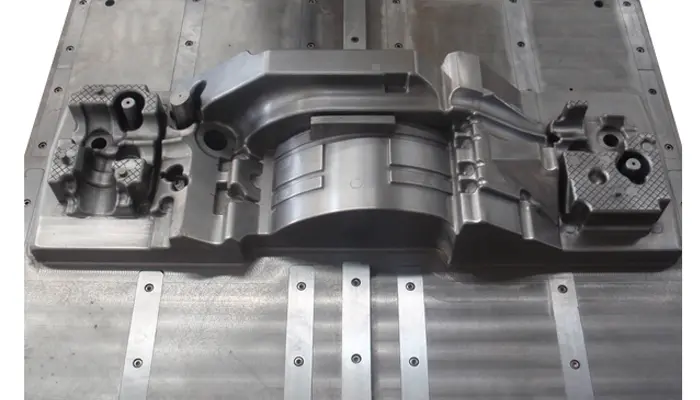Most of the ductile iron used in actual production is close to the eutectic composition. Thick-walled castings use hypoeutectic composition, and thin-walled castings use hypereutectic composition, but they are not far from the eutectic composition.
Ductile iron with eutectic composition and hypereutectic composition will first precipitate small graphite balls from the liquid phase during eutectic solidification. Even for ductile iron with hypoeutectic composition, due to the increase in supercooling of molten iron after spheroidization and inoculation, small graphite balls will first precipitate at a temperature far higher than the equilibrium eutectic transformation temperature. The first batch of small graphite balls was formed at 1300℃ or even higher.
In the subsequent solidification process, as the temperature decreases, some of the first batch of small graphite balls grow, some dissolve in the molten iron again, and new graphite balls will precipitate at the same time. The precipitation and growth of graphite balls are carried out in a very wide temperature range.
When the graphite nodules grow, the carbon content in the surrounding molten iron decreases, and an austenite shell surrounding the graphite nodules will be formed. The time when the austenite shell is formed is related to the cooling rate of the casting in the mold: when the cooling rate is high, the carbon in the molten iron does not have time to diffuse evenly, and the austenite shell is formed earlier; when the cooling rate is low, it is conducive to the uniform diffusion of carbon in the molten iron, and the formation of the austenite shell is later.
Before the formation of the austenite shell, the graphite nodules are directly in contact with the molten iron with a high carbon content, and the carbon in the molten iron is easy to diffuse into the graphite nodules, causing the graphite nodules to grow. After the austenite shell is formed, the diffusion of carbon in the molten iron to the graphite nodules is hindered, and the growth rate of the graphite nodules drops sharply. Since the crystallization latent heat released when graphite is precipitated from the molten iron is large, about 3600J/g, and the crystallization latent heat released when austenite is precipitated from the molten iron is small, about 200J/g, the formation of an austenite shell around the graphite nodules and the growth of the graphite nodules are hindered will significantly slow down the release of the crystallization latent heat. Under such conditions, the eutectic solidification can only be carried out by further lowering the temperature to produce new crystal nuclei. Therefore, the eutectic transformation of ductile iron must be completed within a relatively large temperature range, and its solidification temperature range is twice or more than that of gray cast iron, with typical paste solidification characteristics.
In short, the solidification characteristics of ductile iron mainly include the following aspects.
1. Wide solidification temperature range
From the equilibrium diagram of iron-carbon alloy, it can be seen that the solidification temperature range is not wide near the eutectic composition. In fact, after the molten iron is spheroidized and inoculated, its solidification process deviates far from the equilibrium condition. At about 150℃ above the eutectic transformation temperature (1150℃), graphite spheres begin to precipitate, and the temperature at the end of the eutectic transformation may be about 50℃ lower than the equilibrium eutectic transformation temperature.
For alloys with such a wide solidification temperature range, it is difficult to achieve sequential solidification of castings by solidifying in a paste-like manner. Therefore, according to the riser design principle of steel castings, the process scheme of setting a large riser at the last solidified hot spot to achieve sequential solidification of the casting is not very suitable.
Because graphite balls are precipitated at very high temperatures and eutectic transformation occurs, the liquid-solid two phases coexist for a long time, and liquid shrinkage and solidification shrinkage occur simultaneously during the solidification of molten iron. Therefore, it is unlikely to fully supplement the liquid shrinkage through the pouring system and riser like steel castings.
2. The precipitation of graphite during the eutectic transformation leads to volume expansion
Near the eutectic temperature, the density of austenite is about 7.3g/cm3, and the density of graphite is about 2.15g/cm3. During the solidification of the casting, the precipitation of graphite will cause the volume expansion of the system, and about 3.4% volume expansion will occur for every 1% (mass fraction) of graphite precipitated.
Proper use of graphitization expansion in cast iron can effectively compensate for the volume shrinkage during solidification. Under certain conditions, sound castings can be produced without risers.
It should be emphasized that both gray cast iron and ductile iron precipitate graphite and expand in volume during the eutectic transformation process. However, due to the different graphite morphology and growth mechanisms in the two cast irons, the effects of graphitization expansion on cast iron casting performance are also very different.
The flake graphite in the gray cast iron eutectic cluster grows preferentially at the tip that is in direct contact with the molten iron. Most of the volume expansion caused by the growth of graphite acts on the molten iron in contact with the tip of the graphite, which is conducive to forcing it to fill the gaps between austenite branches, thereby making the casting denser.
The graphite in ductile iron grows under the condition of being surrounded by an austenite shell. The volume expansion caused by the growth of graphite balls is mainly through the austenite shell acting on the adjacent eutectic clusters, which may squeeze them apart, expand the gaps between the eutectic clusters, and easily act on the mold wall of the casting mold through the eutectic clusters, causing the mold wall to move.
3. Graphitization expansion during casting solidification easily causes mold wall movement
Ductile cast iron solidifies in a paste-like manner. When the casting begins to solidify, the outer surface layer of the casting at the mold-metal interface is much thinner than that of gray cast iron, and grows very slowly. Even after a long time, the surface layer is still a thin shell with low strength and poor rigidity. When graphitization expansion occurs inside, this shell is not enough to withstand the expansion force and may move outward. If the rigidity of the casting is poor, mold wall movement will occur and the mold cavity will expand. As a result, not only the dimensional accuracy of the casting is affected, but also the shrinkage after graphitization expansion cannot be supplemented, which will cause defects such as shrinkage cavities and shrinkage inside the casting.
4. The carbon content in eutectic austenite is higher than that in gray cast iron
When the gray cast iron eutectic solidifies, the graphite flakes in the eutectic group are in contact with both austenite and the molten iron with a high carbon content. In addition to diffusing from austenite to graphite, the carbon in the molten iron also diffuses directly into the graphite flakes. Therefore, the carbon content in the austenite at the molten iron-austenite interface is relatively low, about 1.55%.
When the eutectic of ductile iron solidifies, the graphite spheres in the eutectic group are only in contact with the austenite shell, not with the molten iron. When the graphite spheres grow, the carbon in the molten iron diffuses into the graphite spheres through the austenite shell. Therefore, the carbon content in the austenite at the molten iron-austenite interface is relatively high, reaching about 2.15%.
When the eutectic of ductile iron solidifies, the carbon content in the austenite may be relatively high. Under the same carbon content and silicon content, if the same cooling rate is maintained, the amount of precipitated graphite is relatively small. Therefore, the volume shrinkage during eutectic solidification will be slightly greater than that of gray cast iron. This is also one of the reasons why ductile iron castings are more prone to shrinkage and shrinkage defects. Maintaining a low cooling rate during solidification is a factor that is conducive to the full precipitation of graphite.





